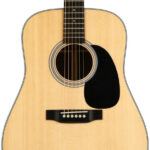Many guitarists, from beginners to seasoned players, often overlook the crucial role of their Guitar Pick Grip. It might seem like a minor detail, but the way you hold your pick significantly impacts your tone, control, and overall playing experience. Experimenting with different guitar pick grips can unlock new dimensions in your playing, and understanding the nuances of each method is key to improving your guitar skills.
There isn’t a single “correct” way to hold a guitar pick, as personal preference and playing style play significant roles. However, understanding the common techniques and their benefits can help you find the best guitar pick grip for your individual needs. Let’s explore three primary methods of holding a guitar pick, each offering unique advantages for different playing styles and pick preferences.
The Versatile ‘O’ Grip: Balancing Control and Tone
Often considered the most common and versatile method, the ‘O’ grip provides a balanced approach to guitar playing. This grip involves forming an elongated ‘O’ shape with your thumb and index finger. The pick is held between the side of your index finger and your thumb, allowing for a comfortable and controlled picking motion.
This technique is favored for its adaptability, making it suitable for various genres and playing styles. It offers a good balance between control for precise picking and enough flexibility for strumming. The ‘O’ grip is particularly beneficial for beginners as it promotes good technique development and allows for a smooth transition between rhythm and lead playing. Many players find this grip comfortable for extended practice sessions and performances.
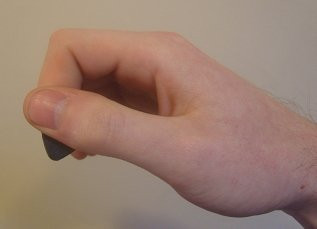 O Grip for Guitar Pick: Balanced Control and Tone
O Grip for Guitar Pick: Balanced Control and Tone
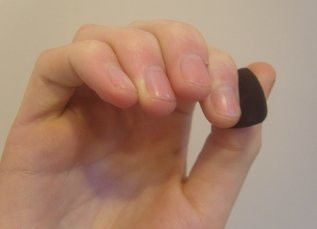 Detailed View of O Grip Guitar Pick Hold
Detailed View of O Grip Guitar Pick Hold
The Flexible ‘Pinch’ Grip: Ideal for Strumming and Light Picks
The ‘pinch’ grip offers a higher degree of flexibility, making it particularly well-suited for strumming and players who prefer lighter gauge picks. In this method, the pick is held between the flat of your index finger and your thumb. This grip allows for more pick movement and less rigidity, which is advantageous for strumming chords and creating a softer, more nuanced tone.
Guitarists who frequently play rhythm guitar or styles that require a lot of strumming, such as folk or pop, may find the pinch grip to be their preferred method. The increased flexibility is also beneficial when using thinner, lighter gauge picks, as it compensates for the pick’s inherent flexibility and provides a more controlled strumming motion. However, this grip may offer less precision for fast, articulate lead playing compared to other methods.
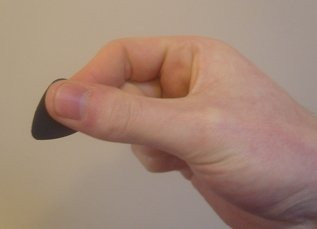 Pinch Grip for Guitar Pick: Enhanced Flexibility and Strumming
Pinch Grip for Guitar Pick: Enhanced Flexibility and Strumming
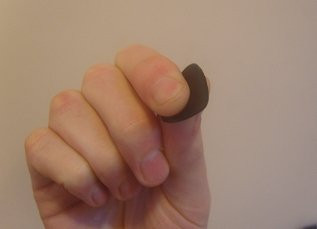 Close-up of Pinch Grip Guitar Pick Technique
Close-up of Pinch Grip Guitar Pick Technique
The Powerful ‘Fist’ Grip: Maximizing Volume and Attack
The ‘fist’ grip, sometimes referred to as the ‘parallel’ grip, is often favored by players seeking a stronger, more powerful tone, particularly those using heavier gauge picks. This method involves curling your index finger more parallel to your thumb, creating a firmer grip on the pick. This robust grip minimizes pick flexibility and maximizes the transfer of energy to the strings, resulting in a louder, more aggressive sound.
Bluegrass and heavier rock genres often see players utilizing the fist grip due to its ability to produce a strong attack and full tone. The reduced flexibility can be advantageous when using thicker, heavier gauge picks, providing more control and preventing the pick from flexing excessively. While this grip excels in power and volume, it may require more practice to achieve the same level of finesse and control as the ‘O’ grip, especially for intricate rhythm patterns.
 Fist Grip for Guitar Pick: Power and Strong Tone
Fist Grip for Guitar Pick: Power and Strong Tone
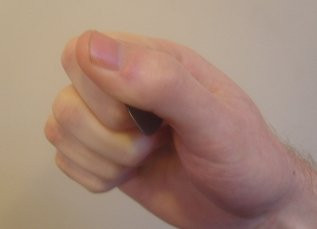 Detailed Image of Fist Grip Guitar Pick Holding Method
Detailed Image of Fist Grip Guitar Pick Holding Method
Experimentation and Finding Your Grip
Ultimately, the best guitar pick grip is the one that feels most comfortable and allows you to achieve your desired tone and playing style. Experimenting with different pick gauges in combination with these various grips is highly recommended. You might find that certain combinations work better for specific musical genres or playing techniques.
While it’s beneficial to explore different methods, especially if you’re a beginner, avoid constantly switching grips if you’re already an experienced player. Years of muscle memory are valuable, and significant changes to your technique can disrupt your progress. Instead, focus on refining your current grip and making minor adjustments as needed to enhance your playing. Short periods of experimentation are fine to satisfy curiosity, but don’t get fixated on changing your grip simply because another guitarist uses a different method. Your personal playing journey and preferences are paramount in finding the ideal guitar pick grip for you.
In conclusion, understanding the nuances of different guitar pick grips and experimenting with them can be a valuable step in your guitar playing journey. Whether you prefer the versatile ‘O’ grip, the flexible ‘pinch’ grip, or the powerful ‘fist’ grip, the key is to find what feels natural and helps you achieve your musical goals. Don’t be afraid to try different techniques, but also trust your instincts and stick with what works best for you in the long run.

